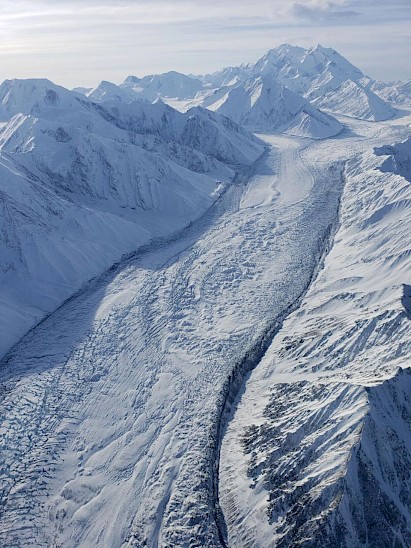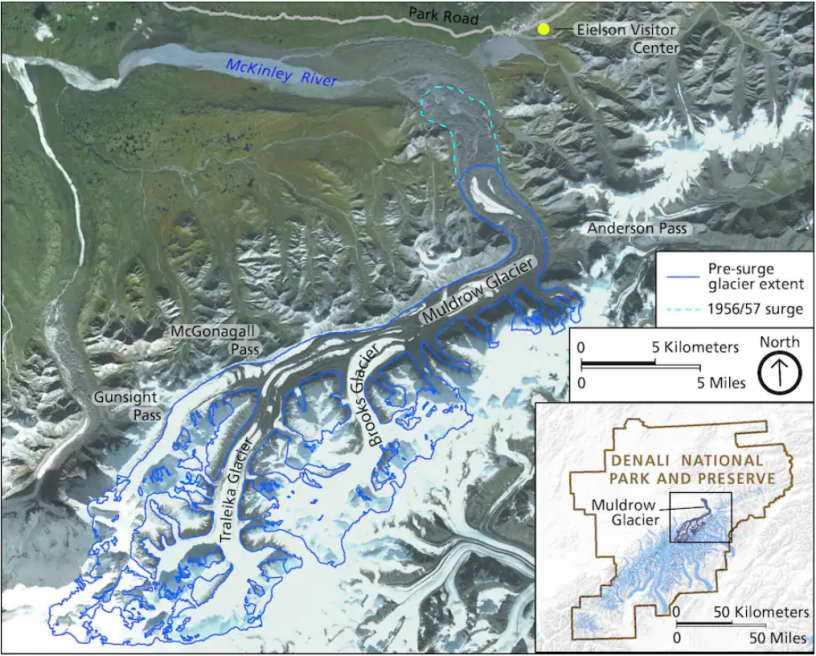Scientists track 'surging' Alaska glacier
 ANCHORAGE — The hummocky hills of ice at the “toe” of Alaska’s Muldrow Glacier have sat undisturbed and covered by tundra for more than 60 years. Soon they will be overtaken by a force that scientists are scrambling to understand — even as they wonder whether climate change will one day halt it completely.
ANCHORAGE — The hummocky hills of ice at the “toe” of Alaska’s Muldrow Glacier have sat undisturbed and covered by tundra for more than 60 years. Soon they will be overtaken by a force that scientists are scrambling to understand — even as they wonder whether climate change will one day halt it completely.
The rare phenomenon began last fall some 12 miles uphill. That’s where the glacier initially started sliding, its smooth surface ice cracking under tremendous, hidden stresses. New crevasses opened and ice cliffs were pushed up in a chaotic jumble. The first witness was a pilot who spied the scene in March as he flew around the north side of Denali, the continent’s tallest mountain.
The Muldrow has been “surging” forward ever since, at speeds up to 100 times faster than normal.
“That’s like Mach 4,” said glaciologist Sam Herreid, who has worked extensively in the Alaska Range. “Imagine you drive to work through a school zone, and it’s 30 miles per hour. Then one day, out of nowhere, you’re sitting in your Honda Civic, and all of a sudden you start to go 3,000 miles per hour.”
He and others are racing to keep pace. Surges are one of the last mysteries for those who study glaciers, in part because they happen so infrequently and in just a fraction of places around the world. The activity is different from a glacier actually growing in size, and it can take decades for the right conditions to develop.
In normal, quiescent years, the Muldrow moves only about three inches a day. Scientists estimate it is now gaining 30 to 60 feet daily. A time-lapse video reveals the accumulation of ice, rock, snow and dirt churning forward like a giant blob. Audio equipment has also been deployed, although snow has acted as a natural insulator and muffled the intense sounds of ice cracking and crashing.
By late-June, the glacier’s terminus will look dramatically different. And for years to come, climbers aiming for Denali’s summit may find a common route up the Muldrow impossible to traverse.
“We’ll be able to see the results of this amazing science,” said Chad Hults, regional geologist for Alaska’s national parks, who has flown over the Muldrow at least a half-dozen times in the past two months.
The prevailing theory of surges is that the natural advance of a glacier causes friction, which melts the deepest ice. Loose gravel traps the meltwater underneath. But as snow and ice accumulate in the glacier’s higher elevations, the mass there gets top heavy. A surge redistributes that mass to lower elevations, with the meltwater serving as a lubricant that helps the glacier pick up speed as it slides downhill.
This last happened with the Muldrow during the winter and spring of 1956-57. Given its record of surges roughly every 50 years, scientists had long anticipated the current event. Their concern is that a warming climate could spell disaster for future surges.
“You wonder, ‘Are you going to ever be able to see the surge again?’ ” Hults said. “I don’t know, because 50 years from now, you might lose enough glacier ice that even if it surges . . . you might not actually even be able to see any difference.”

Alaska Natives from the region call the glacier Henteel No’ Loo,’ and they hold it in high regard. Stories tell of the Athabascans hunting near but not on the glacier, because while vegetation made the ice look solid, local knowledge proved it was not.
The Muldrow isn’t the only Alaska glacier to make headlines within the past century. In 1937, the Black Rapids Glacier started moving downhill and continued about a mile a month for nearly four months. It came close to overrunning what would later become the Richardson Highway, one of the state’s four mainland highways, and nearly swallowed a historic roadhouse that still offers a distant view. Those who watched its stunning advance would have been wearing broad skirts and tailored suits.
A similar scene will play out this month 140 miles due west, only spectators probably will be clad in polypropylene shirts, zip-off pants and hiking boots. They’ll watch from the Eielson Visitor Center in the middle of Denali National Park and Preserve, which offers striking views of Denali’s summit and the Muldrow’s tail end.
For most of the glaciologists and geologists tracking today’s surge, it’s a once-in-a-lifetime thrill.
“These cycles are fairly long, and so it’s difficult to study them,” Herreid said. Indeed, the scientists he relied on for his research, who recorded the 1956-57 event, have all since died.
The contemporary group has distinct advantages, however. It has deployed GoPro cameras, microphones and a GPS unit. A researcher from the University of Idaho provided equipment to collect seismic data that might signal “the harmonic tremor” of the water.
“What we hope to pick up is a temporal and spatial change of that water flow within the glacier because the water is an integral part of the cause of the function of the surge,” Hults said.
As the surge has torn up the ice, the field work has grown increasingly treacherous. Last month, one of the cameras was nearly lost in a deep crevasse. A team in a helicopter rescued it just in time. Since then, Hults has tied himself to one of the craft’s landing skids when he’s doing field work on the glacier. “And if I do slip in,” he said with a laugh, “then I’ll be roped up to the helicopter and it could just lift me out.”
A stream gauge is set up at the McKinley River, which is where all the water underneath the Muldrow is expected to rush out as the surge comes to a close. The scientists think that could begin happening within the next two weeks. The glacier could stop abruptly or slow to a grinding halt over a few weeks or months.
The decades’ worth of accumulated snow and ice near the top of the 39-mile-long glacier will eventually wind up at a lower elevation, where warmer temperatures mean it’s all more likely to melt. “You’re sort of watching this system disappear,” said Joanna Young, a postdoctoral researcher with the International Arctic Research Center at the University of Alaska at Fairbanks.
Yet across the Alaska Range, glaciers are losing mass because of climate change.
“These are glaciers that are born in really tall mountains with really cold weather systems throughout a lot of the year,” Young said. “In the past, they’ve had the opportunity to grow really large. In Alaska and everywhere else in the world, we’re seeing volume loss and retreat in these glaciers as the summer season is getting longer and warmer and they are getting less snow throughout the course of the winter.”
The downstream consequences, including higher sea levels and less meltwater to help recharge river systems, have global consequences. “These aren’t just trivial landscape features,” she said.
“There is a certain sense of tragedy to it all for sure,” she said. “I think some of the most exciting moments are those moments when you feel like a glacier isn’t just a stagnant ice cube on the landscape but has these dynamic, almost living attributes.”
You can return to the main Market News page, or press the Back button on your browser.

